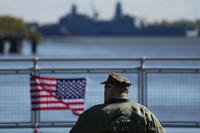I spoke to some folks from Textron today about a new vehicle they’re unveiling down at the Army’s annual winter symposium underway in Florida. Called the Small Combat Tactical Vehicle Capsule (SCTVC), it’s a bolt-on armored capsule that fits onto the existing Humvee chassis, giving the vehicle Mine Resistant Ambush Protected (MRAP) level protection from IED and mine blasts.
With the new vehicle (shown next to a Humvee), Textron hopes to get a piece of the Army’s $1 billion plus, 60,000 vehicle up-armored Humvee recap contract due out sometime this spring. The SCTVC also appears to be a good fit for the Marines who are trying to shed some weight from their battle fleet, said Mark Savarese, a spokesperson for Textron’s Marine and Land Systems.
The Marines have awarded Textron a contract for 3 upgraded Humvee test vehicles, after putting the SCTVC through a series of blast and ballistic tests; further testing will focus on mobility and durability.
One of the big problems with the Humvee when hit with IEDs is that its flat bottom acts as a gas trap, concentrating the blast energy upward into the vehicle. The original design also had lots of gaps and holes in the frame that allowed flames inside.
Textron’s bolt-on SCTVC capsule has a V-shaped bottom, so the interior is completely encapsulated in steel armor, including the fuel tank. The hull itself is lifted further off the ground than the up-armored Humvee, providing all important clearance between exploding ordinance and the crew compartment. More space is available inside, allowing troops to get in and out more quickly. Savarese said. While the SCTVC adds armor, it doesn’t tax the Humvee engine and drive train. “The brilliance is in the simplicity of the design,” he said.
I can see why the Marines are taking an interest in the SCTVC. Marine Corps Commandant Gen. James Conway has been having fits about the burgeoning size and weight of his vehicle fleet as the Corps bought more and more of the bulky MRAPs. As it turns out, buying a vehicle tailored for a very specific operating environment, that is paved roads in urban areas with lots of IEDs, might not be the best solution for a service that’s supposed to be expeditionary and amphibious.
Conway is on record saying that the Joint Light Tactical Vehicle (JLTV), a Humvee replacement that weighs in at 22,000 pounds, is too heavy for his strategically mobile shock troops.
How bad is the Marine’s battle fleet weight gain? I came across a post over at the Navy centric Information Dissemination blog that illustrates the point. According to Lt. Col. Roger Galbraith, Marine units have more vehicles than even 10 years ago. So many more that even if the Marines were to get the 38 amphibious ships they originally said they needed to haul two Marine Expeditionary Brigades (the new 30 year shipbuilding plan and QDR give them 29-33), they would still be forced to leave vehicles behind.
The heavier vehicles also make the amphibious ships too top heavy, he writes. To make his point, he provides the following illustration:
Old Vehicle: M151 Jeep: 3,000 lbs.
Currents ships designed around: M998 Soft-door HMMWV: 5,000 lbs
Currently used on the ground: Up-Armored HMMWV: 7,600 lbs
Future vehicle, Joint Light? Tactical Vehicle: 22,000 lbs
I think he’s a little light on the up-armored Humvee; I think its weight is closer to the 12,000 pounds range. What’s clear is the Corps is facing a real problem with new bulkier and heavier vehicles crowding out limited space on amphibs and will have to rethink their vehicle modernization plans.
-- Greg









